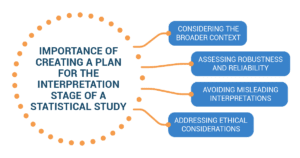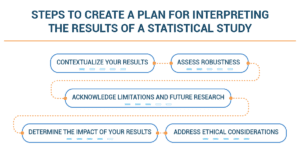Imagine this: You’re sitting in a movie theater 🎥🍿, eagerly awaiting the start of a highly anticipated film. As the lights dim and the opening scene unfolds, you find yourself engrossed in the story, captivated by the characters and their journey. But imagine if, at the climax of the movie, the screen suddenly goes blank☠️, leaving you bewildered and confused. 😮 The absence of a proper ending would leave you questioning, speculating, and desperately seeking closure.
Now, let’s pause and consider how this scenario relates to our everyday lives. We encounter situations where we crave clear explanations, reliable conclusions, and meaningful insights. Whether it’s making decisions based on a product review, interpreting the results of a scientific study, or understanding the implications of a news headline, we all seek understanding and clarity in the face of information overload.
As researchers, it is not enough to collect and analyze data; we must also have a plan for interpreting the results of our statistical study. Just as a movie needs a well-crafted ending 🎬 to leave us satisfied, a statistical study requires careful planning to ensure the results are not left open-ended or misleading. The interpretation stage is crucial because it allows us to make sense of the data and draw meaningful conclusions. 📊
In this article, we will explore why creating a plan for interpretation is important and discuss the steps involved in creating such a plan. 📝✅
Why Is it Important to Create a Plan for Interpreting Results

- Considering the broader context: By creating a plan, we ensure that our results are viewed within the larger literature, domain, and context of our topic of interest. This helps us understand how our findings contribute to existing knowledge and how they may impact the field.
- Assessing robustness and reliability: A clear plan enables us to assess the strength and reliability of our findings. We can determine if our results hold up under different conditions, consider potential confounding factors, and ensure that our conclusions are well-supported.
- Avoiding misleading interpretations: Having a plan helps us anticipate ways in which results could mislead us or our audience. It encourages critical thinking and helps us identify potential biases, limitations, and alternative explanations that need to be considered.
- Addressing ethical considerations: A plan allows us to anticipate potential ethical issues that may arise from the misuse of our study’s findings. By considering privacy concerns, conflicts of interest, and the responsible use of data, we can ensure that our research is conducted ethically and does not harm individuals or communities.
What Are the Steps for Developing the Plan

1. Contextualize your results: Find existing studies related to your topic of interest and consider how your findings fit into the larger domain, social, economic, or historical context. This will help you understand the significance of your results and their implications.
- Let’s say you conducted a survey to understand the impact of social media on teenagers’ mental health. To interpret your results, you would find existing studies on the topic to see how your findings fit into the larger research context on social media and mental health. This will help you understand if your results support or add new insights to the existing knowledge.
2. Assess robustness: Decide if you need to perform a sensitivity analysis to test the stability of your results. Anticipate confounding factors that might influence your findings and plan to address them. Consider reproducing your results using different statistical models and seek peer review to validate your findings.
- Suppose you conducted a survey to investigate the relationship between hours of sleep and exam scores. To assess the robustness of your findings, you might perform a sensitivity analysis by comparing the results when considering different variables like study habits or extracurricular activities. This will help you determine if your initial findings hold true under different circumstances.
3. Acknowledge limitations and future research: Create a list of potential sources of bias and expected limitations of your study. Be clear about what questions your study is not meant to answer. This transparency helps to provide a realistic interpretation of your results and identifies areas for further investigation.
- Imagine you conducted a research project investigating the effects of music on productivity. In interpreting your results, you would create a list of potential sources of bias, such as individual preferences for specific music genres or the influence of external factors like noise levels. You would also acknowledge the limitations of your study, such as a small sample size or limited study duration. Additionally, you would identify questions that your study did not answer, such as the long-term effects of music on productivity.
4. Determine the impact of your results: If your results will drive decision-making, create a list of possible decisions that depend on the study’s outcome. If your research is intended for broader audiences, plan how to translate your results into non-technical language and highlight key takeaways and implications that are meaningful and accessible to these audiences.
- Suppose you conducted research on the benefits of school uniforms. If your results show that uniforms lead to better discipline and improved academic performance, you can create a list of possible decisions based on these findings, such as recommending the implementation of uniforms in schools or suggesting further studies to explore the effects on student well-being.
5. Address ethical considerations: Anticipate privacy issues, conflicts of interest, or potential misuse of your study’s findings. Consider how you will handle and communicate these ethical considerations responsibly, ensuring the ethical use of data and the protection of individuals’ rights.
- Suppose you conducted a study on the effects of a new medication. You would need to anticipate privacy issues by ensuring that participants’ personal information remains confidential. You would also need to address potential conflicts of interest by disclosing any financial relationships with the pharmaceutical company producing the medication. This transparency ensures the ethical use of the study’s findings.
Space: Investigating the Relationship Between the Presence of Black Holes and the Distribution of Galaxies
 Lily has always been captivated by the mysteries of the universe. She decides to undertake a statistical study to investigate the relationship between the presence of black holes and the distribution of galaxies in the cosmos. Lily begins her journey by immersing herself in existing studies related to her topic of interest. She delves into scientific journals, online resources, and books to gather knowledge about black holes and galaxy distribution. By understanding the broader context of her research, Lily can plan how her results will contribute to the field and shed light on our understanding of the cosmos.
Lily has always been captivated by the mysteries of the universe. She decides to undertake a statistical study to investigate the relationship between the presence of black holes and the distribution of galaxies in the cosmos. Lily begins her journey by immersing herself in existing studies related to her topic of interest. She delves into scientific journals, online resources, and books to gather knowledge about black holes and galaxy distribution. By understanding the broader context of her research, Lily can plan how her results will contribute to the field and shed light on our understanding of the cosmos.
As Lily continues her research, she considers the potential influence of additional factors, such as the presence of other astronomical phenomena, that could impact her results. To ensure the reliability of her study, Lily plans to conduct a sensitivity analysis and replicate her findings using different statistical models.
She thinks about how peer review may assist in validating her results. She knows it’s important to understand the limits of her study and plan for future research. To do this, Lily creates a list of things that might make her study less accurate, like choosing certain information or not being able to directly observe everything. She considers a non-space example about what would happen if she only included students from one school in her study; the results may not apply to all students. Or if she only collected data from a specific age group or gender, the findings may not be applicable to a broader range of people. She wants to be open about what her study can and cannot show. She also thinks about the questions her study can’t answer yet, which helps guide future studies.
Lily also thinks about how her study could be useful in real life. She makes a list of decisions that could be influenced by her findings. She also considers how to explain her research to different groups, like people who make important decisions or those who are interested in space. She wants to make sure everyone can understand and benefit from her work.
Lastly, Lily cares about doing the right thing. She thinks about things like privacy, conflicts of interest, and how her study’s results could be used. By thinking ahead and being responsible, Lily ensures that her research is ethical and contributes positively to the world of science.
Lily shows us how important it is to make a detailed plan for understanding the results of a statistical study. She does this by thinking about the bigger picture, making sure her findings are strong and reliable, acknowledging any limitations, deciding how to use the results, and being aware of ethical concerns. Lily’s careful planning helps make her research trustworthy and meaningful. Her hard work inspires other scientists to explore space and make exciting discoveries too.